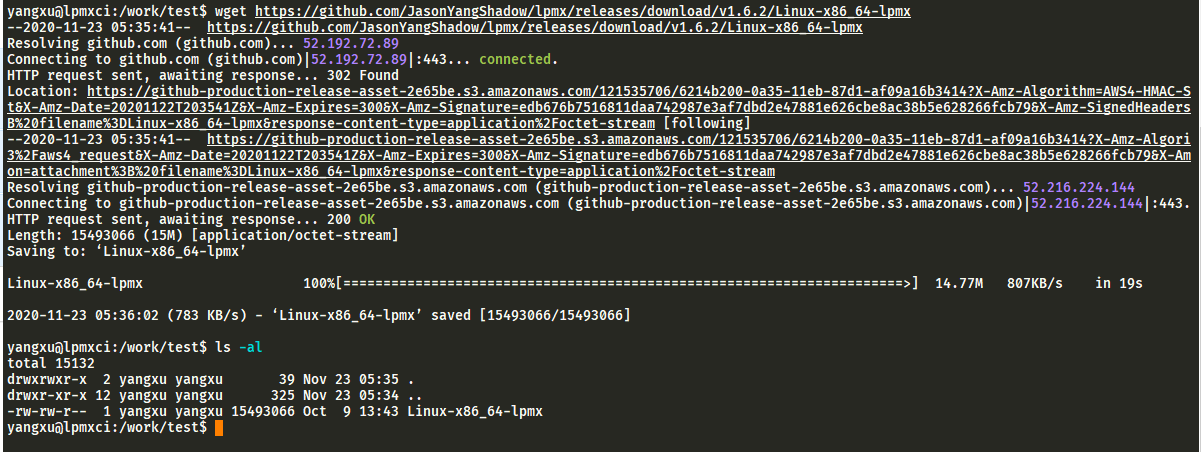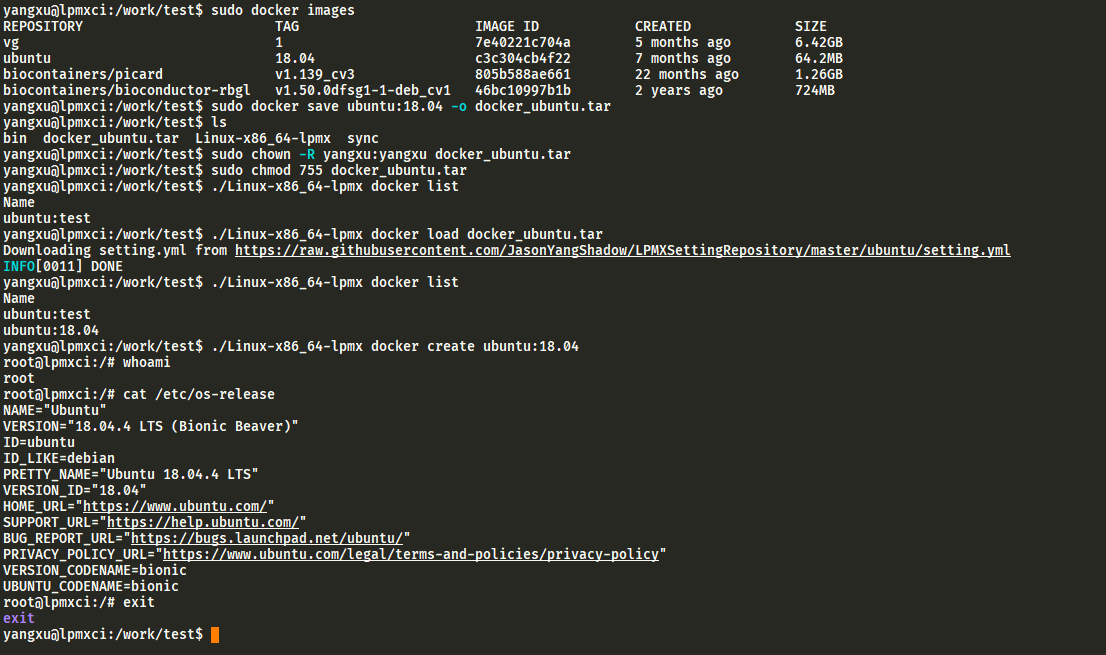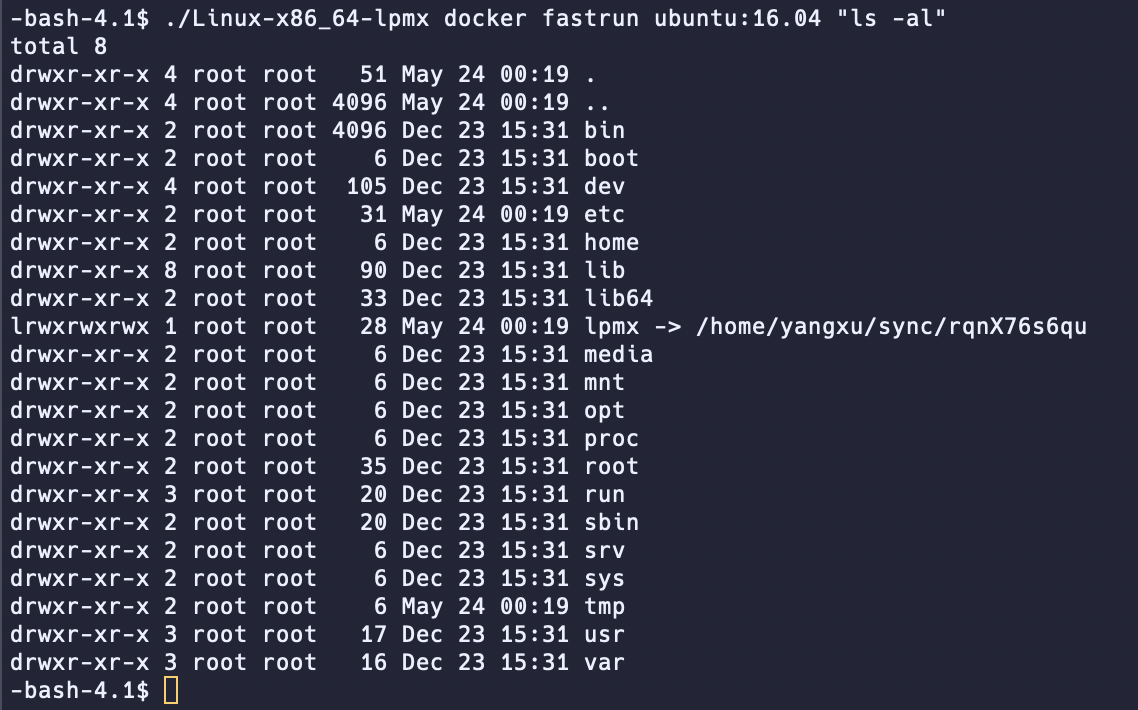-
Notifications
You must be signed in to change notification settings - Fork 6
Home
HOME | Biocontainer Compatibility Report | Package Installation Benchmark | GPGPU Access | Containerize Canu Assembler | Composability Feature | Developer Notice | Incompatible Images
lpmx rootless container
Usage:
lpmx [command]
Available Commands:
destroy destroy the registered container
docker docker command
download download files from online storage
expose expose program inside container
get get settings from memcache server
help Help about any command
init init the lpmx itself
list list the containers in lpmx system
resume resume the registered container
set set environment variables for container
singularity singularity command
uninstall uninstall lpmx completely
update update dependencies
version show the version of LPMX
Flags:
-h, --help help for lpmx
Use "lpmx [command] --help" for more information about a command.
-
Download lpmx from lpmx release page, currently only the Linux x86_64 is supported. Though we can compile binaries as well as libraries for x86 architecture, our primary goal is supporting x86_64 arch.

-
chmod a+x lpmx && ./lpmx init
lpmx will automatically download its dependencies and initialize itself.
For offline initialization, please download dependency from github)
The command for offline initialization is:
"./lpmx init -d dependency_package_path"

- 'lpmx docker search ubuntu' to search available images on docker hub, here using ubuntu as an example.
- 'lpmx docker download ubuntu:14.04' to download the image from docker hub, remember to use "image:tag".
For offline users, please use 'lpmx docker commit container_id' to commit container to image, which is similar to command 'docker commit', for migration or images transmission among different machines, use 'lpmx docker package image_name' to generate tar ball. Copy this tar ball to new machine, then use 'lpmx docker add tar_ball' to your new lpmx system.
- 'lpmx docker create ubuntu:14.04' to create container based on the already downloaded image.
And now you should be inside container.
'lpmx docker' is a sub-command to process Docker images on DockerHub, by using this command, users can search, download, create and package container based on Docker images.
Usage:
lpmx docker [command]
Available Commands:
add add the local docker image to system
commit commit docker container
create initialize the local docker images
delete delete the local docker images
download download the docker images from docker hub
fastrun run container in a fast way without switching into shell
list list local docker images
load load the 'docker save' generated tar ball to system
package package the docker images from docker hub for offline usage
reset reset local docker base layers
search search the docker images from docker hub
Flags:
-h, --help help for docker
Use "lpmx docker [command] --help" for more information about a command.
- 'lpmx docker add':
- add local image packaged via command 'lpmx docker package'
- 'lpmx docker commit':
- commit container content(similar to 'docker commit')
- 'lpmx docker create':
- create contaienr based on downloaded docker images from Docker Hub
- 'lpmx docker delete':
- delete local downloaed Docker images
- 'lpmx docker download':
- download docker images from Docker Hub
- 'lpmx docker fastrun':
- create, run and destroy a container in a fast way, it is usually used for fast testing
- 'lpmx docker list':
- list all downloaded Docker images
- 'lpmx docker load':
- load the 'docker save' generated tar ball
- 'lpmx docker package':
- package local images to tar balls
- 'lpmx docker reset':
- reset downloaded images(re-extraction)
- 'lpmx docker search':
- search images on Docker Hub
-bash-4.1$ lpmx docker search
Error: accepts 1 arg(s), received 0
Usage:
lpmx docker search [flags]
Flags:
-h, --help help for search
(Note) result contains target name and available tags for this name. If name does not exist in docker hub, then error occurs.

-bash-4.1$ lpmx docker download
Error: accepts 1 arg(s), received 0
Usage:
lpmx docker download [flags]
Flags:
-h, --help help for download
-m, --merge merge all layers(optional)
-p, --pass string optional
-u, --user string optional

-bash-4.1$ lpmx list
list command is the basic command of lpmx, which is used for listing all the containers registered
Usage:
lpmx list [flags]
Flags:
-h, --help help for list

-bash-4.1$ lpmx docker create
Error: accepts 1 arg(s), received 0
Usage:
lpmx docker create [flags]
Flags:
-h, --help help for create
-n, --name string optional
-v, --volume string optional
(Note) lpmx will automatically create and open bash shell.

-bash-4.1$ lpmx docker delete
Error: accepts 1 arg(s), received 0
Usage:
lpmx docker delete [flags]
Flags:
-h, --help help for delete
-p, --permernant permernantly delete all layers of the target image(optional)
(Note) docker image is removed locally
-bash-4.1$ lpmx docker commit
Error: required flag(s) "id", "name", "tag" not set
Usage:
lpmx docker commit [flags]
Flags:
-h, --help help for commit
-i, --id string required
-n, --name string required
-t, --tag string required
(Note) lpmx will commit current container and create an image with given name and tag

-bash-4.1$ lpmx docker package
Error: accepts 1 arg(s), received 0
Usage:
lpmx docker package [flags]
Flags:
-h, --help help for package
-p, --pass string optional
-u, --user string optional
(Note) lpmx will create a package (tar.gz) file containing evrything

-bash-4.1$ lpmx docker add
Error: accepts 1 arg(s), received 0
Usage:
lpmx docker add [flags]
Flags:
-h, --help help for add
(Note) lpmx will import previously packaged tar file, so that you can create container based on newly imported image.

-bash-4.1$ lpmx docker load
Error: accepts 1 arg(s), received 0
Usage:
lpmx docker load [flags]
Flags:
-h, --help help for load
(Note) lpmx will import 'docker save' command generated tar file. Note that, this comamand only receives the output of 'docker save' command.

-bash-4.1$ lpmx docker fastrun
Error: accepts 2 arg(s), received 0
Usage:
lpmx docker fastrun [flags]
Flags:
-h, --help help for fastrun
-v, --volume string optional
(Note) lpmx will create a container and run the given command inside it, then will remove it after run. Similar to 'docker run --rm -it IMAAGE COMMANDS'
'lpmx singularity' is a sub-command supports Singularity image (SIF image), by using this command, users can import and create containers based on Singularity images. (Experimental Feature Currently)
singularity command is the advanced command of lpmx, which is used for executing singularity related commands
Usage:
lpmx singularity [command]
Available Commands:
create initialize the local singularity images
delete delete the local singularity images
fastrun run container in a fast way without switching into shell
list list local singularity images
load load local sif image
Flags:
-h, --help help for singularity
Use "lpmx singularity [command] --help" for more information about a command.
Similar to 'lpmx docker' command, 'lpmx singularity' command supports loading SIF images, and create containers based on loaded images. Commands listed above have the same options as listed in 'lpmx docker' command.
'lpmx init' command is used for initializing the basic system folder of lpmx, it stores information of containers and other information(Users should call this command before using lpmx)
init command is the basic command of lpmx, which is used for initializing lpmx system
Usage:
lpmx init [flags]
Flags:
-d, --dependency string dependency tar ball(optional)
-h, --help help for init
-r, --reset initialize by force(optional)
- 'lpmx init' supports offline initialization with dependency tar ball, i.e, 'lpmx init -d dependency.tar.gz', initializing lpmx in offline mode.
'lpmx list' command is used for listing the information of all the registered containers, including containerid, container rpc port(NA for no rpc port)
list command is the basic command of lpmx, which is used for listing all the containers registered
Usage:
lpmx list [flags]
Flags:
-h, --help help for list

'lpmx resume' command is used for resuming stopped container, you need to use this command with container id argument
resume command is the basic command of lpmx, which is used for resuming the registered container via id
Usage:
lpmx resume [flags]
Flags:
-h, --help help for resume

destroy command is the basic command of lpmx, which is used for destroying the registered container via id
Usage:
lpmx destroy [flags]
Flags:
-h, --help help for destroy
Example:
./lpmx destroy containerid

'lpmx expose' command is used for exposing applications inside containers to host, i.e, users can directly call apps inside containers from host OS.
To run this command, you should stop current running container.
expose command is the advanced command of lpmx, which is used for exposing binaries inside containers to host, id is the container id containing the exposed program, name is the customized name given by end-users, path is the full path of program inside the container
Usage:
lpmx expose [flags]
Flags:
-h, --help help for expose
-i, --id string required
-n, --name string required
-p, --path string required

'lpmx get' command is used for getting app settings from memcache server, values are set by using 'lpmx set' command.
get command is the basic command of lpmx, which is used for getting settings from cache server
Usage:
lpmx get [flags]
Flags:
-h, --help help for get
-i, --id string required
-n, --name string required
'lpmx get' is used for getting the value of 'lpmx set' commands.
set command is an advanced comand of lpmx, which is used for setting environment variables of running containers, you should clearly know what you want before using this command, it will reduce the performance heavily
Usage:
lpmx set [flags]
Flags:
-h, --help help for set
-i, --id string required(container id, you can get the id by command 'lpmx list')
-n, --name string required(should be the name of libc 'system calls wrapper')
-t, --type string required('add_map','remove_map')
-v, --value string required(value(file1:replace_file1;file2:repalce_file2;))
'lpmx set' is very important for providing composability feature, an existing/unexisting path can be mapped to any paths from the host or in other containers. e.g. lpmx set -i CONTAINER_ID -t add_exec -n PATH_IN_CONTAINER -v REPLACED_PATH_ON_THE_HOST
check the following gif:

